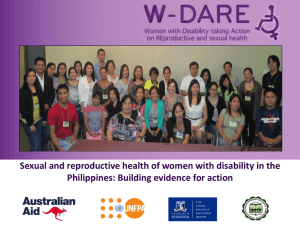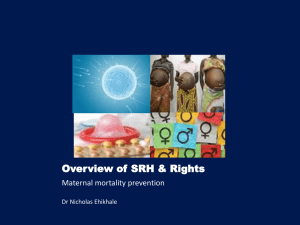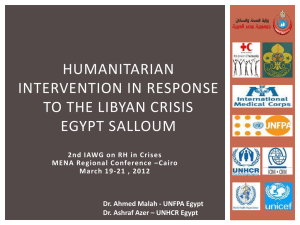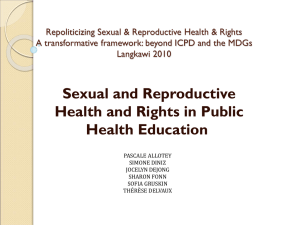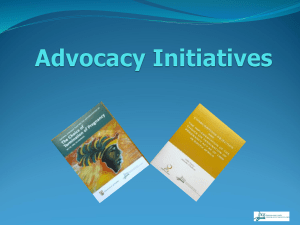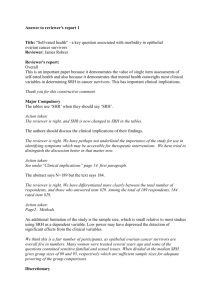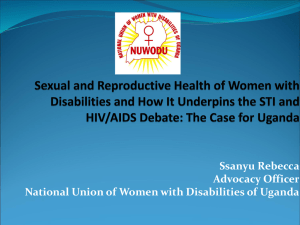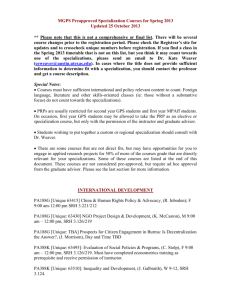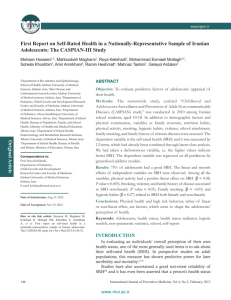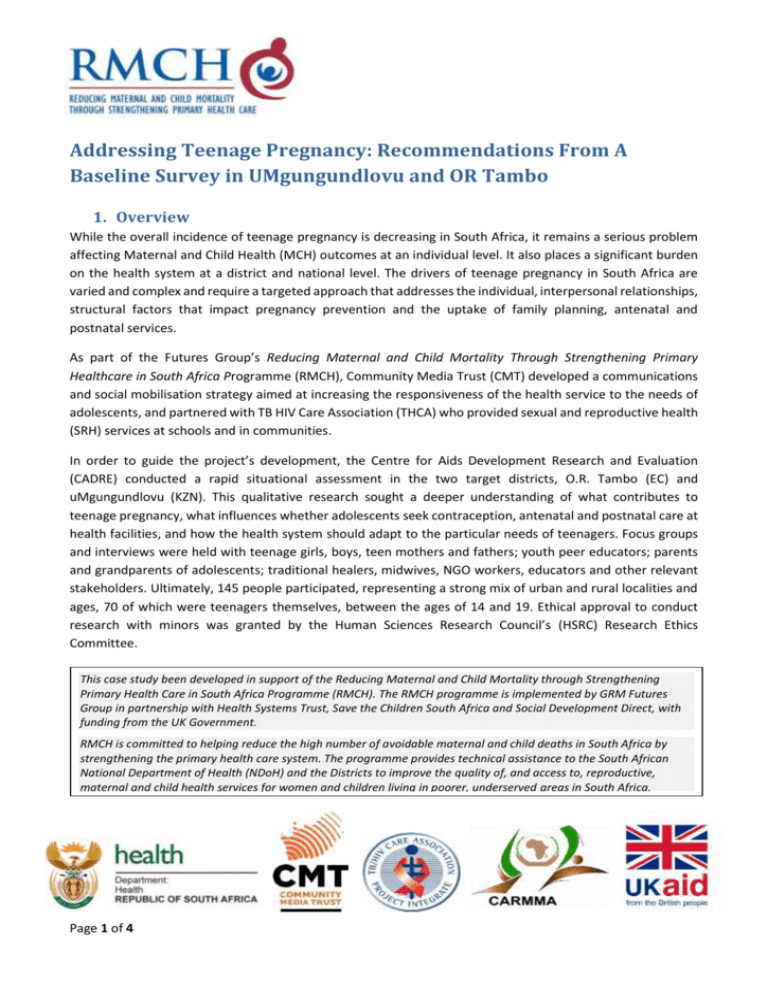
Addressing Teenage Pregnancy: Recommendations From A
Baseline Survey in UMgungundlovu and OR Tambo
1. Overview
While the overall incidence of teenage pregnancy is decreasing in South Africa, it remains a serious problem
affecting Maternal and Child Health (MCH) outcomes at an individual level. It also places a significant burden
on the health system at a district and national level. The drivers of teenage pregnancy in South Africa are
varied and complex and require a targeted approach that addresses the individual, interpersonal relationships,
structural factors that impact pregnancy prevention and the uptake of family planning, antenatal and
postnatal services.
As part of the Futures Group’s Reducing Maternal and Child Mortality Through Strengthening Primary
Healthcare in South Africa Programme (RMCH), Community Media Trust (CMT) developed a communications
and social mobilisation strategy aimed at increasing the responsiveness of the health service to the needs of
adolescents, and partnered with TB HIV Care Association (THCA) who provided sexual and reproductive health
(SRH) services at schools and in communities.
In order to guide the project’s development, the Centre for Aids Development Research and Evaluation
(CADRE) conducted a rapid situational assessment in the two target districts, O.R. Tambo (EC) and
uMgungundlovu (KZN). This qualitative research sought a deeper understanding of what contributes to
teenage pregnancy, what influences whether adolescents seek contraception, antenatal and postnatal care at
health facilities, and how the health system should adapt to the particular needs of teenagers. Focus groups
and interviews were held with teenage girls, boys, teen mothers and fathers; youth peer educators; parents
and grandparents of adolescents; traditional healers, midwives, NGO workers, educators and other relevant
stakeholders. Ultimately, 145 people participated, representing a strong mix of urban and rural localities and
ages, 70 of which were teenagers themselves, between the ages of 14 and 19. Ethical approval to conduct
research with minors was granted by the Human Sciences Research Council’s (HSRC) Research Ethics
Committee.
This case study been developed in support of the Reducing Maternal and Child Mortality through Strengthening
Primary Health Care in South Africa Programme (RMCH). The RMCH programme is implemented by GRM Futures
Group in partnership with Health Systems Trust, Save the Children South Africa and Social Development Direct, with
funding from the UK Government.
RMCH is committed to helping reduce the high number of avoidable maternal and child deaths in South Africa by
strengthening the primary health care system. The programme provides technical assistance to the South African
National Department of Health (NDoH) and the Districts to improve the quality of, and access to, reproductive,
maternal and child health services for women and children living in poorer, underserved areas in South Africa.
Page 1 of 4
2. Key factors influencing teenage pregnancy
Below is a summary of the findings about teenage pregnancy in OR Tambo in the Eastern Cape and
UMgungundlovu in KwaZulu-Natal. This information is organised into five key messages followed by
recommendations on how to address the issues around teenage pregnancy that the findings raise.
2.1 Vulnerability and context matter
Early sexual debut is a significant factor in teenage pregnancy. Why?
Young women in poor socio-economic conditions are vulnerable
Parental absence, parental substance abuse, child abuse and neglect increase vulnerability
Low self-esteem in girls results in unhealthy relationships
Transactional sex for financial needs and desires fuels early sexual debut
Peer pressure and the need for love and social approval fuels early sexual debut
Low risk perception, enjoyment of sex in the moment and being blinded by love impacts decision
making about early sexual debut
Westernisation and exposure to sexualised media fuels early sexual debut
Choices for falling pregnant were influenced by the need to:
Cement relationships with a partner
Elevate social status by proving fertility, having a child and being a parent
Feel loved and valued
Most teenage parents expressed feeling socially isolated noting:
A strong sense of shame and having disappointed their parents
Financial hardship
Difficulty in balancing the pressures of parenting and education
Being treated differently, by their peers and parents who prioritised the needs of their children at
their expense
2.2 Knowledge is vital
Termination of pregnancy
Decisions about termination of pregnancy (TOP) are influenced by a lack of knowledge of SRH rights and the
subsequent submission to health care worker values, negative attitudes and actions to prevent youth
accessing safe TOP. Peer pressure, family and partners also play a role.
2.3 Communication is key
Poor communication across generations reduces knowledge about sex and sexuality
Cultural taboos do not allow for conversations about sexuality in families and therefore teenagers do
not clearly understand the physical changes that happen during puberty or how pregnancy happens
Elders’ negative perceptions of today’s youth as lacking respect, self-control and refusing to listen to
their elders further hinder intergenerational communication
Youth seek advice about sexual and reproductive health from their peers who are poor sources of this
information
Negative community attitudes and taboos about sexuality lead to shame and secrecy about sex, hiding
pregnancy, and delayed presentation for antenatal services
Page 2 of 4
Reliable SRH information sources
Community Health Workers (CHW’s) are a valuable resource for SRH information for youth and play a
significant role in supporting the uptake of antenatal care amongst pregnant teenagers
Partner communication
Partner communication, decision-making about sex and negotiation of safe sexual practices are
negatively influenced by culture and gender norms that support unequal power relations and social
expectations of male and female roles. This is worse in transactional and intergenerational
relationships
2.4 Taking responsibility
Male involvement
Male involvement in taking responsibility for safe sexual practices and parenting is negatively
influenced by gender norms, social expectations and the way SRH services are provided
Parental involvement
Parental involvement, family support and talking openly about sexual health can enable uptake of
contraception to prevent unintended pregnancy
2.5 Barriers to using known methods to prevent pregnancy
Access to services
SRH services are inaccessible due to negative attitudes of healthcare workers, fear of lack of
confidentiality, clinic opening times and long waiting times at clinics
Attitudes and information regarding contraception that influence contraceptive use include:
Male dislike of condoms, girls belief that their partners will love them more if they have unprotected
sex
Misconceptions about contraceptives and lack of understanding of how they work
Lack of support for using contraceptives and for addressing side effects
3. Recommendations for addressing the above factors included:
3.1 The Department of Education’s (DoE) Life Orientation (LO) curriculum and Peer Educators (PEs) are
key sources of SRH education for youth in schools. It is important to ensure that they provide
comprehensive sex education. The ages at which various aspects of SRH information is provided
should be in keeping with what we know about the early sexual debut amongst youth. It is also
important that youth are supported in understanding their sexuality and how their bodies work before
they go through puberty. This education should familiarise youth with healthy sexual practices and
assist them with skills to manage and negotiate relationship dynamics and gender issues that impact
on their sexual decision making. This includes support for self-esteem issues and education on
contraceptives, dual protection, and SRH rights and responsibilities. LO teachers and PEs need to be
fully equipped and supported by the DoE with values clarification and SRH information that will enable
them to engage with youth appropriately and provide the required SRH information.
3.2 A focus on social capital that links youth to the local resources for healthy SRH practices can be drawn
upon in strategies to address teenage pregnancy. This requires attention to unexplored symbolic,
Page 3 of 4
cultural, psychological and social assets. This focus can be included in comprehensive SRH education
curricula but can also be drawn on by healthcare workers during their SRH counselling and education
sessions with youth. NGOs providing SRH related education in schools are also an important source of
this information and education.
3.3 Healthcare workers attitudes is consistently highlighted as a key barrier to youth accessing SRH
services. The establishment of Adolescent and Youth Friendly Services (AYFS) is a crucial factor in
addressing the SRH needs of youth. The Department of Health needs to provide Health Care Workers
responsible for SRH services, including facility-based and School Health Nurses, with training and
support for their key role in the provision of SRH information and services to youth. This should be
linked to the establishment of AYFS and should include values clarification training such as the Health
Care Workers for Teens training aimed at assisting healthcare workers with cross-generational
communication on the topic of sexuality. The training should also include information on all options
for preventing pregnancy so that healthcare workers are able to offer youth a range of options and
help them to choose the one most appropriate for their needs and circumstances.
3.4 Youth expressed a strong need to communicate with significant elders about their SRH needs and
experiences. Caregivers need support for this engagement both in terms of how to conduct these
conversations and what information is required. Youth also need support in broaching the subject
with elders to access the information and support that they require. These needs can be addressed
through the provision of support groups dealing with intergenerational SRH communication. These
groups could be organised in schools and health facilities by the Departments of Health and Education
and local NGOs and CBOs.
3.5 Community Health Workers are a key resource for SRH information, access to condoms and
assessment and referral to health professionals for SRH services. Opportunities with CHWs can be
maximised to address the SRH needs of youth in community settings. For this, it is important for the
Department of Health to strengthen training and support of CHWs and ensure that they equipped
with the required supplies to provide SRH support to youth.
This material has been published by the RMCH Programme with funding from UK aid from the UK Government.
The views expressed do not necessarily reflect the UK Government’s official policies. All reasonable precautions
have been taken to verify the information contained in this publication.
Page 4 of 4

